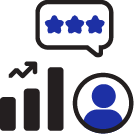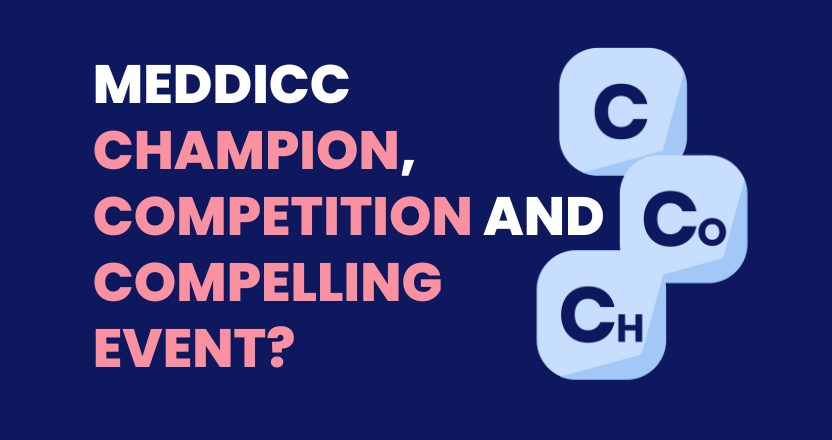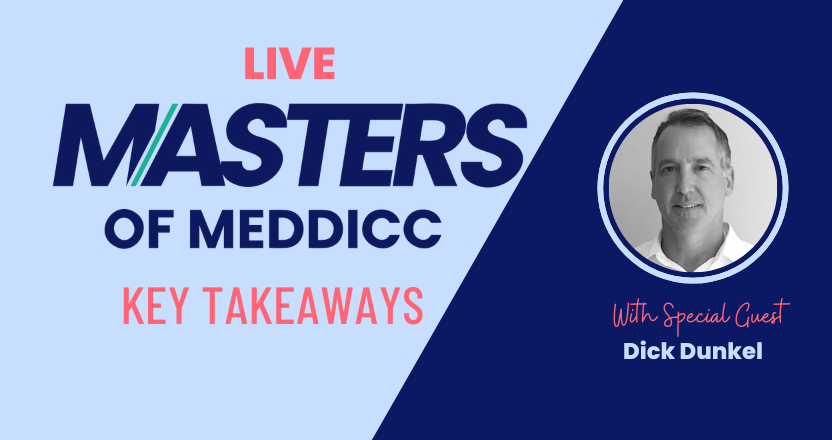MEDDIC HAS MYTHS
It is true - There are a lot of myths about MEDDIC, and that's OK. I'd rather there be misunderstandings, misconceptions, and myths about MEDDIC than if nobody was talking about it at all!
The truth is, whenever you scratch the surface of these myths you'll usually find the source of the myth is someone who doesn't properly understand MEDDIC.
The best example of this scenario is the common myth that MEDDIC is imposed upon the customer and subsequently delivers a poor experience for them.
Here are a couple of examples of how that myth presents itself:
The Top 100 LinkedIn SALESPERSONS
This is a strange sample of the myth because it likens MEDDIC to SPIN. SPIN is a questioning technique and MEDDIC is a qualification methodology.
'When the value is there - budgets are found' - this is true. But, value is only found by solving a pain that a customer has and quantifying it. That's the I and the M of MEDDIC.

The Sales Trainer
This example borders on two myths that could go into a second Myths of MEDDIC list:
1) That MEDDIC is a checklist that needs to be completed in a linear fashion by the seller
2) That all the elements of MEDDIC have to be satisfied in 'one single call'.
Quite the contrary. MEDDIC guides the seller to focus on the factors that qualify a deal. It is not how you should talk to your customers.
VIDEO: THE TEN MYTHS OF MEDDIC
Prefer to watch than read? We've got you. Tune in here to watch Andy talk through the Top 10 Myths of MEDDIC
Let's get into the Myths:
In no particular order and, of course, relevant to MEDDIC, MEDDICC, and MEDDPICC
MEDDIC MYTH 1: MEDDIC is a sales process
MEDDIC is not a sales process. It’s a qualification framework used to help revenue teams better qualify their opportunities.
A sales process is a set of steps that a salesperson takes to take a deal buyer from the early stage of awareness to a closed sale. MEDDIC is a methodology that you use to qualify each step of the sales process.
Why does this matter? It matters for the same reason as to why it matters if you think of MEDDIC as a messaging framework - it means that people expect it to do more than its purpose, or worse still, people think they can’t use MEDDIC because they already have a sales process in place.
As a result, people misunderstand MEDDIC and think it’s about how they talk to their customers. It’s not.
MEDDIC MYTH 2: Customers Dislike MEDDIC
How does the customer know you are using MEDDIC?
Even if you are leaning too much into MEDDIC in the sales conversation is going to be focused on three areas:
1. The pain and the value relating to that pain
2. How the decision is being made and upon what criteria
3. Who are the stakeholders that are involved and what do they care about
Those are essential things for a salesperson to be focused on. If the customer is genuine about the opportunity, then focusing on those things will be a good thing for the customer.
The only customer who will be upset with that approach is unqualified... So, in that case, MEDDIC has done its job, right?
MEDDIC MYTH 3: MEDDIC is just for forecasting
If you see MEDDIC as just a tool to help you forecast, you aren’t using it to its full potential.
Sure. MEDDIC is the best framework out there to help sellers accurately forecast. But, it only leads to accurate forecasting because it allows sellers to know first and foremost are they in with a chance of winning a deal and even should they be working it at all.
Once they’ve established that, they can use MEDDIC to help them figure out what to do next to win.
MEDDIC MYTH 4: If we use MEDDIC, we will qualify out of too many opportunities.
This one I heard relatively recently. A sales leader felt their total addressable market was small and that by implementing MEDDIC, they’d rule out too many opportunities and not have enough pipeline left.
In the case of this sales leader, this wasn’t actually the case. Their TAM was huge, but if it was a legitimate concern, then the problem isn’t with MEDDIC but with their proposition.
Using a soft approach to qualification to create more pipeline is daft. I am trying to think of a nice way to say it… But, there is just no way to sugar coat it.
You’ll just end up with a bigger pipeline of unqualified deals, and your sales team will be busy doing a poor job of managing lots of deals instead of a great job on qualified deals.
MEDDIC MYTH 5: You don’t need any more letters than MEDDIC
I rarely hear this one anymore… But, there is the odd person out there who thinks that the evolution of MEDDIC to include Competition and Paper Process is unnecessary…
I discussed this in this video. In brief, when MEDDIC was created there was no SaaS, there was nothing like the level of complexity in the Paper Process in the nineties where software was bought outright, no data issues, no security issues, no privacy issues. On top of that, there is vastly more competition today.
Likewise, people get uncomfortable if you include other elements in MEDDIC. My favorite response to this is that Dick Dunkel literally invented MEDDIC, and he uses MEDDPICC, and the P stands for Partners, not Paper Process.
MEDDIC MYTH 6: MEDDIC is just for sales teams
One of the best things about MEDDICC is that it acts as a common language that can be used across the entire revenue team.
I have actually done a video about this too. But in brief, MEDDIC is best used when you use it in your GTM to describe who to market to and what the different personas will be interested in. It’s obviously great as a framework throughout the sales process and post-sale for customer success to know who bought, why they bought, and what the process was like for them buying. Super useful for renewals and upsells.
MEDDIC MYTH 7: We are Different
This myth generally comes from the sales leader who thinks that their company is unique… Their product proposition has to be sold differently, or their customers buy differently.
MEDDIC has success in the private sector, public sector, any industry you can think of, all different types of product and service…
MEDDIC orientates to how customers buy… And B2B customers buy the same way.
The only place where this myth holds any water is if you are selling a commodity that is indistinguishable from other providers. But even then, I still believe MEDDIC can play a part in helping you understand things like the stakeholders, elements of the decision, and what problem you are solving.
MEDDIC MYTH 8: It has to be implemented
Interesting one this one, because there really isn’t a pre-set gold standard with MEDDIC. Some organizations have it built into their CRM, sales process and messaging, while others use it completely free of anything else and just use it to capture their position in a deal on an ad-hoc basis.
The point is that while the more thought you put into implementing MEDDIC to complement your revenue operations, the better value it will give to you, it doesn’t have to be implemented for you to get value from it.
Using MEDDIC just to check your deals qualification status on your own on a notepad is better than not using it at all.
MEDDIC MYTH 9: MEDDIC has a bad culture
The first thing I want to do is not dismiss this as a myth… Because the truth is there are some companies out there that use MEDDIC that have a horrible sales culture.
However, and this is an important thing… it is not MEDDIC that enables a bad culture. It can’t; it is just a framework.
But, if you have bad leadership who care about the wrong metrics and the wrong levers of success, then MEDDIC will give them a tool to be worse…
The thing is, if you are thinking about MEDDIC as something that is culture or leadership-related, then you are thinking about it wrong… MEDDIC is a tool that is actually most valuable when used by individual contributors.
MEDDIC MYTH 10: MEDDIC is for leadership
As discussed in Myth number 8, The MEDDIC must be implemented myth. You can get value from MEDDIC merely by just using it to check yourself against your own deals.
As an individual contributor, you need to uncover pain and quantify it with value. That’s where Implicating the Pain and Metrics come in.
You need to understand who the stakeholders are - the ultimate decision-making authority, your Champion, and your Competition. That’s where the two C’s and E come in.
And you need to know what they are basing their decision on and how they will be making it, the two Ds - Decision Criteria and Decision Process.
Just by thinking about this as an individual contributor, you will stay oriented upon the right things in your deal, regardless of your leadership.
That's a wrap!
That concludes the Ten Myths of MEDDIC.
What do you think? Did we miss any out? Are there any that you don't agree with?
Until the next time, May your Champions be Strong 💪
.png)
.png)








